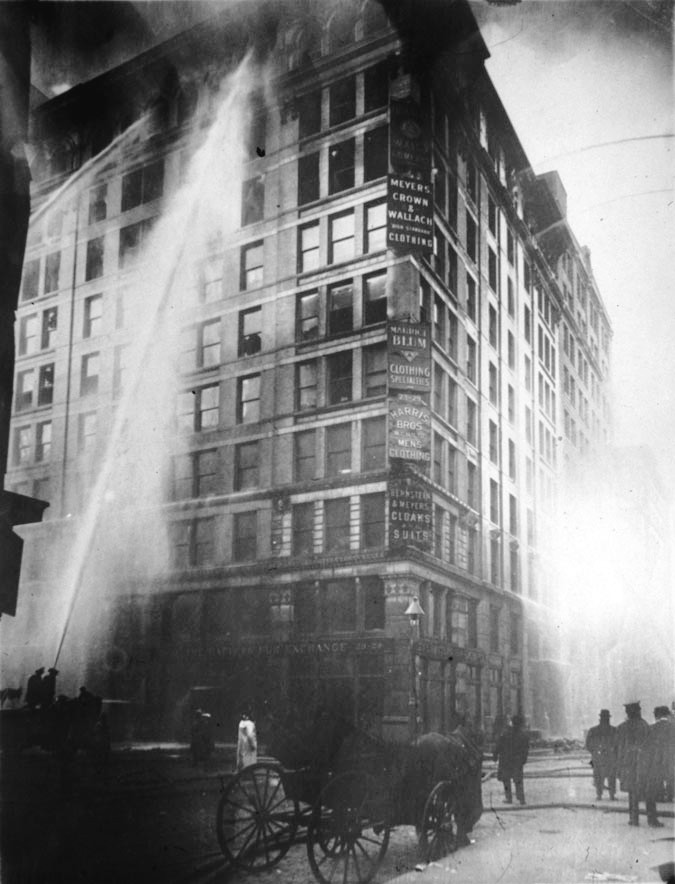It was March 25, 1911, in New York City. It was a Saturday afternoon just like any other at the Triangle Shirtwaist factory, where young immigrant women sat in front of sewing machines, day in and day out, sewing. But on that day a fire broke out, causing the deaths of 146 garment workers. Among those who died in the flames and smoke were 123 women and 23 men.1 Many even jumped or fell to their deaths out the windows, making this event a man-made disaster and one of the deadliest industrial disasters of all time.

The factory was located in the Asch Building at Washington Place in Greenwich Village, one of the wealthiest neighborhoods in the city. The factory occupied the eighth, ninth, and tenth floors of the ten-story building. Max Blanck and Issac Harris were the owners of the factory, and their company was known as the largest firm in the business at the time. They styled women’s blouses known as “Shirtwaists,” which were paired with tailored skirts. This attire had become the standard in fashion for women in the early twentieth century. They were also known to resemble men’s shirts. When it came to their workers, they had hired operators who then contracted out for factory workers. The company itself only dealt with the contractors, and there was no fixed rate of pay for the workers.2 At the time, the factory employed about five-hundred employees, mostly young immigrant women who were of Italian or Jewish descent. These women worked up to eleven-hour shifts on weekdays, and twelve-hour shifts on Saturdays, and they earned between $7-$12 dollars for a 52-hour week. Many of these women were the breadwinners of their household, and their income was sometimes not sufficient to cover their needs.
Towards the end of the workday on that Saturday evening in 1911, a fire broke out around 4:00 pm. The fire started in a scrap bin under one of the cutter’s tables on the eighth floor from what is believed to have come from a cigarette. A manager tried to put the fire out with a hose but the hoses valve was rusted shut, and rotten away. The fire spread quickly and the workers panicked. There was one fire escape that quickly collapsed, and four elevators, which out of the four only one was working. The elevator held twelve people at a time, and it managed to make four rescue trips before it broke down.3 With no other alternatives available, people began throwing themselves out the windows, and some were even crushed to death trying to get out. Workers tried to take the stairs, but the exit doors only opened inward and were kept locked by factory management to prevent theft by the workers, as the managers would check their workers belongings every day before they left for the day.

Celia Saltz Pollack, a survivor of the 1911 Triangle Shirtwaist Fire said,
I remember on that day there was a lot of singing and happiness in the shop because it was the end of the week and we got paid. We were soon all going to go home. When the fire started I was sitting at my machine. I looked up and saw the fire near the cutting tables but I did not think it was so terrible. What was terrible was that the fire spread in a split second.
By the time the firefighters arrived, they came to the realization that their ladders could only extend up to the sixth or seventh floors. With no other option, sixty-two workers jumped and fell to their deaths, while the remaining died from the smoke and flames within the building.4

This fire not only pushed issues of unsafe factories and immigrant exploitation into the public consciousness, but for the first time the fire allowed for attention to be brought to deplorable conditions of New York factories.5 Women obtained well deserved attention onto current work conditions and safety measures in the workplace. Although the Triangle Shirtwaist Factory fire brought a feeling of resentment and heartbreak to many, this event and its victims will always be remembered.
- Ric Burns, “Triangle Shirtwaist Fire,” New York Times (1923-Current File), Nov 24, 1999. ↵
- Jonathan Fink, “Conflagration and Wage: The Triangle Shirtwaist Factory Fire, 1911,” TriQuarterly, no, (2009): 135-136. ↵
- Gale Encyclopedia of U.S. Economic History, s.v. “Triangle Shirtwaist Fire,” by Thomas Carson and Mary Bonk. ↵
- Mia Lynn Mercurio, Régine Randall, “Tributes Beyond Words: Art Educators’ Use of Textiles to Memorialize the Triangle Shirtwaist Factory Fire.” Journal for Learning through the Arts no. 1 (2016): 4-5. ↵
- Albert Marrin, Flesh and blood so cheap: The Triangle fire and its legacy (New York: Alfred A. Knopf, 2011), 23-25. ↵



135 comments
Manuel Aguilera
As there was no mention of it, I am curious to know if there were no other doorways that at least lead to the 6th floor so they could exit through the windows there. Plus, why did no one try to open the locked door? Was no one aware of the situation? Nonetheless, I am sad that such an event had to occur just so people could become more aware of the most dangerous things to them, this could even be said about many things that are going on today.
Benjamin Voy
I had not heard of this catastrophe before but after this i realise how shocking this really was. Its awful that there was no problem health and safety rules in factories at these times because if there was something like this could never have happened. This in detailed review of this horrific disaster really shed light on how our modern rules has helped the work place. Great article
Abigale Carney
Very interesting article! I have actually read a book related to this event in history, it was called “Ashes of Roses” by Mary Jane Auch. This event was so heartbreaking, and showed the horrific working conditions of the young people in the factory. It is awful to even think about people jumping from the buildings in order to escape the fire. Although this was a horrendous moment in American history, I am glad that we bettered our working conditions so that we are now safe in our working in environments so this won’t happen again.
Justin Garcia
This event was heart breaking. It is truly horrifying that there was a time where rules and regulations where not in place in factories. The fact that companies would be fine with sacrificing the safety of it’s workers for saving money is disturbing. I am glad that over the course of time workers are now in a better state of well being at work. Though more needs to be done to help workers, It is great to know that an event like this will not be recreated.
Alexandria Martinez
Before this article, I didn’t know that the events that took place that day had even happened. However it is not surprising to me that this event occurred because back then the workers were not treated fairly and apparently not given good safety procedures. If the building had working elevators, more fire escapes, or the doors were able to open than all of the lives could have been save. It is a shame that in order for good change to happen something bad must first occur.
Valeria Hernandez
Josselyn Arrieta-Meraz tells the story of a devastating event in American history. The triangle shirtwaist factory fire is a memorable event in the industrial industry world as it brought attention to fire hazards and the importance of worker’s safety. The author is objective and describes the tragedy without being too cruel or inconsiderate. Arrieta-Meraz created an interesting yet captivating article.
Deanna Lummus
I remember hearing about this story back in middle school. Everyone was shocked because today things like that would never happen. Mainly because we have so many work place policies that nothing can ever go wrong anymore. It is sad that this had to happen just to get people to realize the dangers of smoking inside and even not having effective exit strategies. I can’t imagine something like that happening today unless it was an actual attack like on 9/11.
Ryann Cervantes
It’s truly sad the horror those men and women had to experience. Also, how it takes these terrible circumstances in order to finally draw light to issues such as work conditions and safety precautions. These people should be remembered and that day as a lesson in always making sure factories and other manufacturing shops are designed with something more in mind than just profit and putting people to work.
Brianda Gomez
This article is both great and heartbreaking. It is disappointing to know that many lives were lost in factories for companies to pay more attention to the safety of their workers. It truly is heartbreaking to read how people were even jumping out of the building in order to try and save themselves by being burned to death in the fire. The featured image really caught my attention and made me realize that it was in New York.
Samman Tyata
Great article. I really liked the way how you have structured you article. Also, your title really attracted my attention. It is really sad and depressing to know about this event. It was depressing to read that the firefighters could not help the workers and many died in the process. Overall, this article does a great job of showing how bad the working conditions were. To sum it up, it was good read.